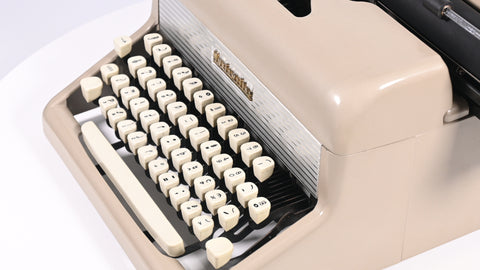20 typewriter facts and stories you did not know.
A company dropped typewriters from an Airplane! and why there is no “1” key on many typewriters ??
These are just two out of many facts and stories I learned about typewriters since 2015 while building up our typewriter restoration business, Mr and Mrs vintage typewriters.
Join me today as we delve into the lesser-known facts and captivating stories behind these charming machines.
- The arise of Portable Typewriters:
Not until the mid 20s, Portable typewriters gained popularity.
The first successful portable typewriters appeared on the market in 19091.
These machines were designed with lighter parts than standard models, making them more compact but less sturdy1.
Long before laptops, portable typewriters were the go-to choice for writers, journalists, and poets who needed to work from different locations.
Definitely not as portable as todays writing tools.
- Typewriters & art..
Also known as ASCII (ASS KEE) art,
This form of typewriter art began appearing in the late 19th century.
Artists would use the typewriter’s keys to create visual art, a practice that has continued into the digital age with computer ASCII art.
The Best known Artist is our friend James Cook, whose art is spreading globally. His art and talent is out of this world.
Most recently, his drawing of the Arc De Triumph went viral on Social Media hitting more than 32 Million Views in less than two weeks…
- Carbon Paper and Multiple Copies:
Before photocopiers, typewriters were used to create multiple copies of documents.
Carbon paper was inserted between sheets to transfer ink from the original to subsequent copies.
Add this “Walid” fact, I hate Carbon papers as they stain the typewriter frame and nearly impossible to clean such stains.
4- Where is the Delete Button?
On a typewriter, the concept of a “Delete” button as we know it from modern keyboards doesn’t quite apply.
However, there are ways to correct mistakes:
There was no immediate way to erase a mistake.
Typists would either use a pencil eraser designed for typewriter ink or apply correction fluid, commonly known as “white-out,” to cover the error and then retype the correct character once the fluid dried.
I am strongly against using fluids & even the erasers as they leave a lot of residues inside the typewriter that will harm it in the long run.
There’s a backspace key which allows you to move back one space to correct a letter, but that doesn't correct a big mistake.
If you cant live with it, you will need to manually retype the entire page ( make a disappointing sound)
5 . What is the point from a QWERTY Keyboard Layout ?:
Contrary to popular belief it was not created to slow down typists.
A QWERTY keyboard layout aimed to improve efficiency by placing frequently used letters apart to avoid collisions of typebars.
So, The QWERTY layout was originally designed to prevent jamming of the keys.
- DVORAK keyboard layout to replace the QWERTY..
The Dvorak keyboard layout, patented in 1936 by August Dvorak and his brother-in-law William Dealey, tried to offer an alternative to the universal QWERTY layout.
Its design aims to enhance typing speed, reduce errors, and alleviate repetitive strain injuries.
Dvorak minimizes awkward finger movements by placing common letter combinations within easy reach.
Letters are typed by alternating between hands, creating a rhythmic flow. This approach increases speed and reduces fatigue.
& Vowels and frequently used symbols reside on the left side of the keyboard
Despite its advantages, Dvorak has not replaced QWERTY as the standard layout due to historical factors and ongoing debates about its benefits.
- The “Shift” Key and Capitalization:
Early typewriters did not have a dedicated “shift” key.
Previously, To type uppercase letters, a separate key was made for capital letters, numbers and symbols. Which made the keyboard big,
The introduction of the shift key by Remington in its No. 2 model in 1878 was revolutionary. allowing easy toggling between lower-case and uppercase letters, which significantly increased typing speed and efficiency.
8 .Typewriter Music and Compositions:
Composer Leroy Anderson took typewriters to the concert hall. His playful and whimsical composition, aptly titled “The Typewriter,” features all the familiar sounds of a typewriter—dings, clacks, and clitter-clattering.
In performances, a soloist plays the typewriter while the orchestra accompanies. The effect is delightful, and it’s a testament to the creative ways artists incorporate everyday objects into music.
Not to forget the innovative band, known as the Boston Typewriter Orchestra, creates music using typewriters as their instruments.
they exploit the physicality of typewriters. The inner mechanisms of these antique machines serve as a bass, while the strong typing sound becomes a percussion that takes center stage.
9- Music writers…
Beyond the realm of performance, typewriters have also been used historically for composing music.
In the 19th century, music typewriters were invented to help composers avoid the laborious process of scoring music by hand.
These typewriters had keys for musical notes and symbols, allowing for easier copying and creation of compositions.

The Keaton Music Typewriter, for example, is a notable device from this era.
Another example is The typewriter known as the Musicwriter invented by Cecil S. Effinger, a choral composer, music professor, and inventor.
10 The “Bell” Sound:
Typewriters produced a distinctive “ding” or “bell” sound at the end of each line.
Little did I know that, depending on the typewriter model, you only have around 4 to 7 characters remaining to type after this auditory cue that signaled to the typist to return the carriage as its the end of set margins
This Takes us to number 11
11 - Why there is a Blank Key on my typewriter keyboard??
Got a lot of queries about, What is that Blank Key on the keyboard?
It’s the Margin Release.. that sometimes have an MR on it.
The Margin Release is made to bypass any set margin, whether it’s at the beginning of your line or the end. It allows you to type beyond it .
12- the MR Key’s Hidden Talent!
Often overlooked, The MR on some typewriters is a secret savior for sticky situations.
Found on models like the Hermes typewriters and the Silver Reed Models, the MR key is your go-to solution when keyarms cross paths and jam.
A simple press can set them free.
Yupp.. Magic.
YOU SOLD ME A FAULTY TYPEWRITER...
13- WHERE IS THE 1 KEY??????
In the early days of typewriters, you might have noticed that the number one key was clearly absent on many typewriters.
But fear not, it wasn’t a case of key theft or a manufacturing oversight.
The reason behind this curious omission lies in the clever design choices made by typewriter manufacturers.
Here’s the scoop: Instead of dedicating a separate key for the numeral “1,” they decided to repurpose the lowercase “L” (l).
When typed in its lowercase form, the letter “L” closely resembles the digit “1.”
This dual-purpose approach did not only save space but also reduced manufacturing costs..
So, if you needed to type a “1,” you’d simply press the “L” key, and voilà!
In fact, during the 1930s, the capital letter “I” and the number “1” were still indistinguishable, further justifying this clever workaround.
So next time you encounter an old typewriter missing its “1” key, remember that it’s not a glitch—it’s a design feature!
WHAT ABOOUT THE EXCLAMATION MARK????
it’s a tale of innovation and economy,
Early typewriters didn’t include an exclamation mark either!
But there is always a way. .
Type an Apostrophe
Then, backspace
Type a Period (.):
And you will get an !
14- a tool of liberation for women
Did you know that typewriters were once considered a tool of liberation?
They opened up new job opportunities for women in the 19th century, allowing them to step into offices for the first time as typists and secretaries.
Before the typewriter, the role of the office clerk was predominantly a man’s occupation.
By the early 20th century, the typewriter had become a symbol of modernity and progress, and women typists were at the forefront of this transformation.
The typewriter thus holds a special place in history as a catalyst for social change, altering the landscape of the professional world and paving the way for future generations of women in the workforce.
Now for a little bit of typewriter Scrabble…
- First row of a QWERTY keyboard.
First row on a qwerty keyboard typewriter contains all 8 letters that the word typewriter contains. Not until 2019 i knew this fact from a fellow enthusiast
and funny enough, I had to check 😊
Later I learned about the following facts..
- Peru is the only country name that can be typed using only one row of a keyboard.
- Words like “stewardesses” and “desegregated” can be typed using only the left hand.
- “lollipop” and “monopoly” are examples of words that can be typed using only the right hand.
- Skepticism” is the longest word typed on the typewriter in which you alternate hands every letter.
- The longest top-row word is ‘rupturewort’, a type of plant.
Can you find more interesting facts between typewriters and words??? Let us know in the comments below.
16- Which typewriter company manufactured the 1st electric typewriter?
I did not believe it… as it was strangely odd as this company had a special typewriter design…
The first electric typewriter was produced by the Blickensderfer Manufacturing Company in 1902 .
However, the first electric typewriter to enjoy long-term commercial success was the IBM Electromatic typewriter, introduced in 19353.
Dont fancy Electric typewriters but was surprised that they have been that old.
- Mark Twain and Typewriters...
Mark Twain was the first author to submit a typewritten manuscript for his book "Life on the Mississippi" ,
though it was not typed by Twain himself but by his secretary, Isabel V. Lyon
And after two years...
he stopped using it..
- Blind Writing .. or Upstrike typewriters.
In the late 19th and early 20th centuries, typewriters underwent significant developments.
When using this typewriter, the text being typed remained invisible to the operator until a key was struck and you need to lift the carriage lever to check when needed.
Imagine typing without seeing the letters appear on paper—relying solely on muscle memory and precision.
This design posed challenges but also opened up new possibilities.
The Daugherty and Pittsburg Visible was the first front strike machine.
It was not a practical office typewriter because its long type-bars made alignment difficult to maintain
Interestingly, the first commercially successful typewriter with a writing area facing the user and hidden type bars was the Underwood 1 Typewriter in 1897.
- Siamese typewriters…
They exist..
Such machines were used when one set of characters was not enough.
Some typists needed two different alphabets, or needed to insert a wide variety of symbols in a text like math or scientific symbols.
The solution was this Siamese twin arrangement with two typewriters, with separate keyboards and a joint Carriage to type on..
And its an extremely heavy typewriter ..
And about that airplane drop

- Royal Company dropped typewriters from an Airplane..
Yup...
Not kidding.
It was a dramatic stunt by the Royal Typewriter Company.
In an effort to prove the durability of their typewriters, George Edward Smith, the president of Royal typewriter company, bought an airplane in 1927 and dropped over 200 typewriters in crates with parachutes to dealers over the eastern seaboard of the US.
As per online resources, The company eventually delivered over 11,000 typewriters this way, with only ten being damaged.
This was certainly a unique marketing strategy!

